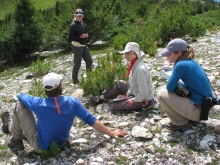You are here
Bullard Spotlight: Diana Tomback and Foundation Species Loss

Diana Tomback, Professor and Associate Chair of Integrative Biology at the University of Colorado-Denver, has had a unique, two-phase Bullard Fellowship. She spent the winter in HF researcher Andrew Richardson's lab on the main Harvard campus, learning new approaches to assessing the impacts of global change at the forest and global scale.
This summer, she's at the Forest collaborating with HF Senior Ecologist Aaron Ellison to study the specific impacts of the invasive hemlock woolly adelgid on eastern hemlock ecosystems.
The eastern hemlock ecosystem presents a parallel to the system that Tomback regularly studies out west: whitebark pine, and its now-widespread pathogen, white pine blister rust.
"The major challenges to global forest health in the 21st century are climate change and ongoing exchange of pests and pathogens around the world," says Tomback. Her recent work has examined the consequences of population declines in whitebark pine in the Rocky Mountains, including reduced likelihood of seed dispersal by Clark's nutcrackers, changes in treeline forest composition and structure, and the loss of ecosystem services and foundation functions.
At Harvard Forest, she hopes to work collaboratively to advocate for attention to these declining foundation species and the adverse changes underway in our North American forests.
- Read a recent article about whitebark pine in the New York Times, with comment from Tomback.
- Learn more about the Forest's Charles Bullard Fellowship program.
(Photo by Marge Meijer shows Tomback's whitebark pine research team at work in Alberta, Canada.)

